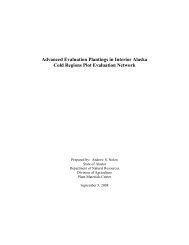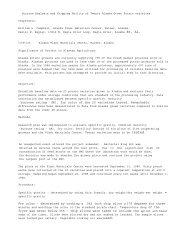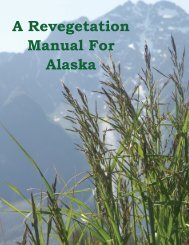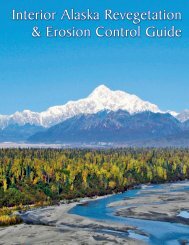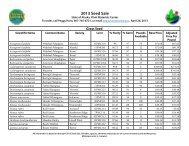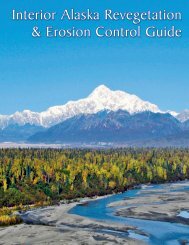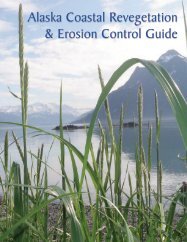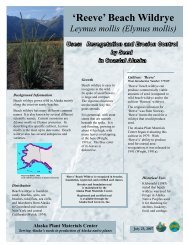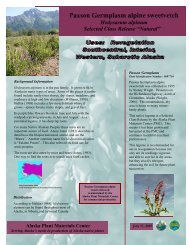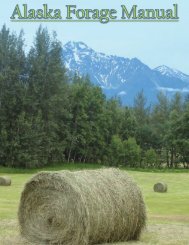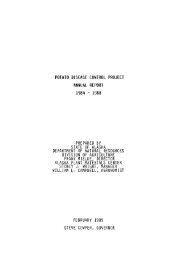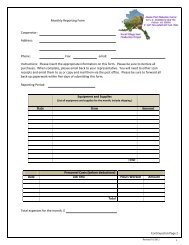Alaska Forage Manual - Alaska Plant Materials Center - State of ...
Alaska Forage Manual - Alaska Plant Materials Center - State of ...
Alaska Forage Manual - Alaska Plant Materials Center - State of ...
Create successful ePaper yourself
Turn your PDF publications into a flip-book with our unique Google optimized e-Paper software.
BEACH WILDRYE<br />
Photo: Brennan Veith Low, AK PM C<br />
<strong>Forage</strong> Value<br />
Beach Wildrye produces a moderate forage yield compared<br />
to other forage grasses such as Smooth brome or Timothy. Its<br />
palatability for browsers is moderate to low. Beach Wildrye<br />
provides moderate to low nutritional value, depending upon<br />
when it is cut or grazed. This grass is usually easily digested,<br />
but can cause impaction problems in horses if consumed when<br />
the moisture content <strong>of</strong> the grass is low.<br />
Distribution and Adaptation<br />
Beach Wildrye is adapted to tidal and coastal areas and can<br />
be found growing along the coast <strong>of</strong> <strong>Alaska</strong>. It prefers coarse<br />
textured, sandy and/or well drained soils. Beach Wildrye will<br />
grow well in soils with a pH between 6.0 and 8.0. This grass<br />
can tolerate excessively wet and droughty conditions, and can<br />
withstand saline soils.<br />
A mature stand <strong>of</strong> Beach Wildrye<br />
Beach Wildrye<br />
Leymus mollis (L.)<br />
Description<br />
Leymus mollis (Beach Wildrye) is a long lived, cool season,<br />
perennial sod forming grass. It grows erect culms 50 to<br />
60 centimeters (20 to 24 inches) tall, from long creeping<br />
rootstocks. Beach Wildrye produces stout, aggressive<br />
rhizomes, which increases its ability to spread. Leaves vary<br />
in length from 25 to 51 cm (10 to 20 inches), and are coarsetextured.<br />
The inflorescence is a stiff spike that is 10 - 25 cm<br />
(4 to 10 inches) in length and roughly 13 mm (½ inch) wide.<br />
Beach Wildrye produces a large sized seed (33,000 seed per<br />
pound) and has low seedling vigor and germination rate. A<br />
fifty percent germination percentage for Beach Wildrye seed<br />
should be considered acceptable.<br />
Uses<br />
Livestock: Beach Wildrye can be used for pasture or silage.<br />
It is moderately palatable to a select class <strong>of</strong> livestock, such as<br />
cattle. This grass can be useful forage if grazed or cut for silage<br />
at the optimum growth stage.<br />
Wildlife: Beach Wildrye is utilized by small mammals and<br />
song birds for forage and cover. Due to its limited range and<br />
moderate palatability, it is generally not consumed by large<br />
grazing or browsing animals such as moose, caribou, elk or<br />
bison.<br />
Culture<br />
Beach Wildrye is commonly grown by planting sprigs from<br />
existing plants. A sprig is the smallest division taken from a live<br />
plant to grow a new plant. Survival percentage is greater when<br />
Beach Wildrye sprigs are planted than from seed. If using seed,<br />
drill to a depth <strong>of</strong> ¼ to ½ inch. Seeding rates depend greatly<br />
upon soil type, moisture, and location. The seeding rates<br />
below only apply to ‘Reeve’ Beach Wildrye, and the European<br />
species Leymus arenarius. An average rate for broadcast<br />
seeding <strong>of</strong> Beach Wildrye is 60 lbs/acre, and 30 lbs/acre when<br />
drill seeding. Including Beach Wildrye seed in a mixture is not<br />
recommended due to its weak ability to compete with other<br />
plants. All seeding rates are determined by using Pure Live<br />
Seed (PLS) calculations, as described in Appendix B.<br />
Appropriate fertilizer ratios depend upon soil type, chemistry,<br />
and location. Soil samples should be collected and analyzed<br />
before fertilizer is applied. Beach Wildrye is highly responsive<br />
to nitrogen fertilizer. 20N-20P-20K fertilizer applied at a rate <strong>of</strong><br />
500 to 600 lbs/acre yield good results.<br />
Management<br />
Beach Wildrye may be severely damaged or destroyed from<br />
traffic that causes compaction. Digestive impaction may occur<br />
in horses if grazed when the moisture content is low. A fungus<br />
and pest called ergot can replace or destroy Beach Wildrye<br />
seed. Ergot occasionally occurs in many cereal crops and<br />
other various grass species. This fungus can be poisonous if<br />
consumed by animals and should be avoided.<br />
35



